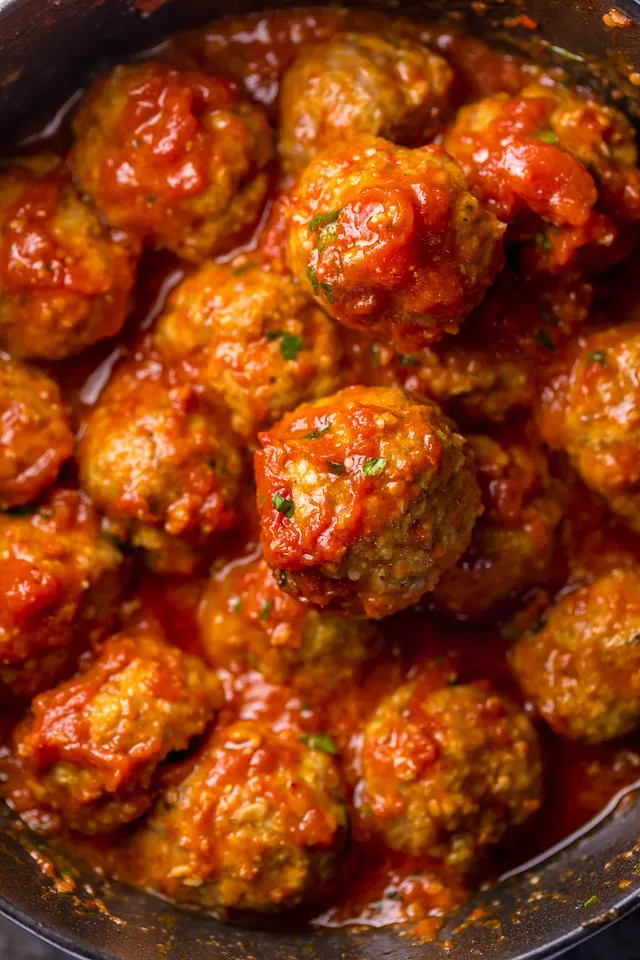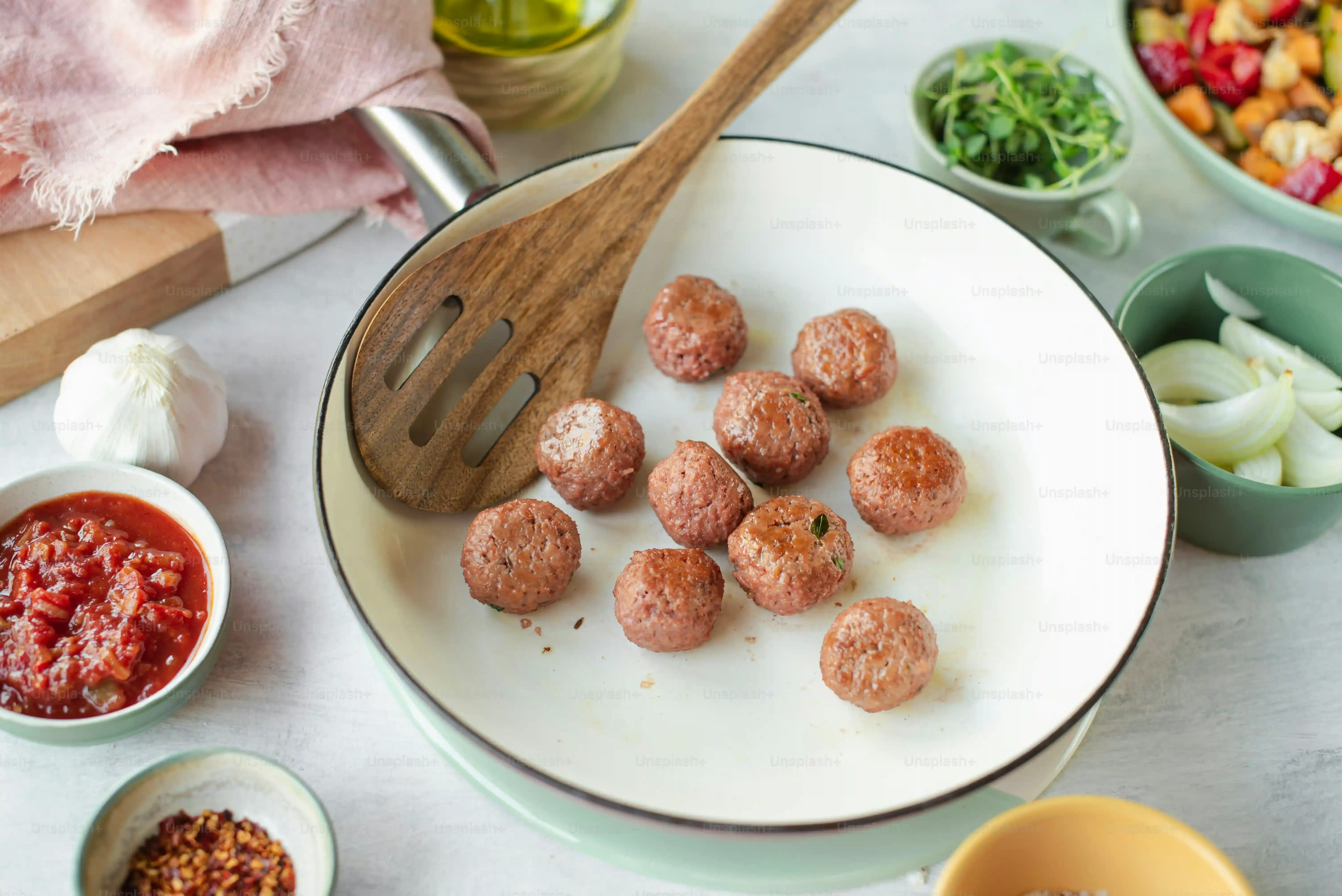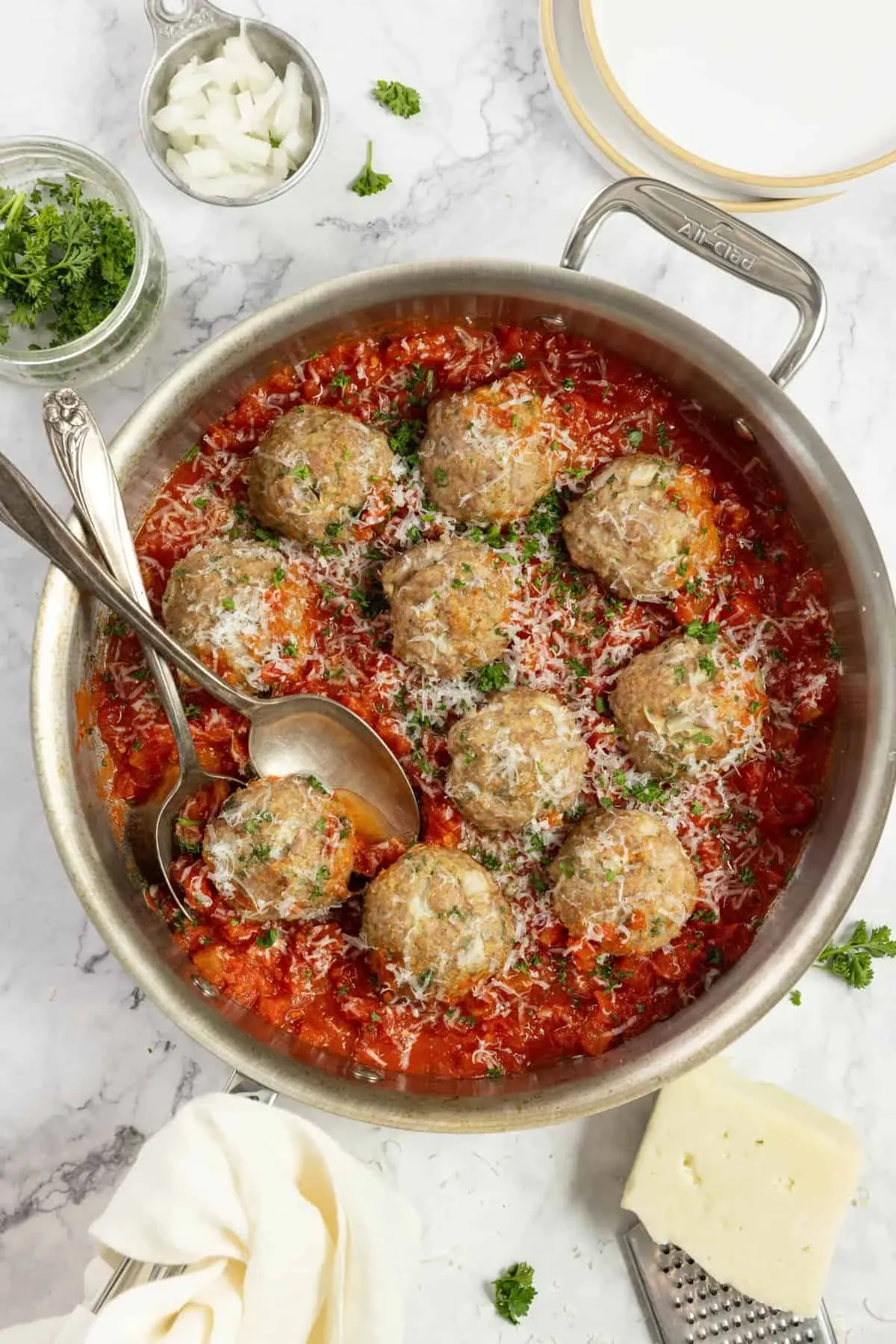Table of Contents
Tired of dense, flavorless meatballs that feel more like edible rocks than savory bites? You are not alone. Many home cooks grapple with dry results or the messy hassle of pan-frying. What if there was a simpler way to get juicy, deeply flavorful meatballs every single time? The secret weapon often hiding in plain sight is Italian sausage. Its inherent seasoning and fat content lay the groundwork for something truly special.
Gathering Ingredients for Your Italian Sausage Meatballs

Gathering Ingredients for Your Italian Sausage Meatballs
Picking Your Italian Sausage Powerhouse
Alright, let's talk sausage. This isn't rocket science, but your choice here sets the tone for the whole italian sausage meatballs recipe. You can go sweet, hot, or a mix of both. Sweet Italian sausage is your mellow friend, perfect for a classic, comforting meatball. Hot Italian sausage? That's for when you want a little kick in the pants. Me? I usually grab one pound of each. It gives you that nice balance – the sweet tames the heat just enough, leaving you with layers of flavor, not just fire.
Forget the pre-ground stuff in the plastic tube if you can help it. Look for links. You'll just pinch the meat out of the casings. It’s a tiny bit more work, maybe 30 seconds total, but the texture is usually better. The fat distribution feels more natural, less like something machine-extruded. Trust me, it makes a difference you can taste.
The Usual Suspects: Binders and Boosters
Next up are the things that hold this party together and crank up the flavor. You need breadcrumbs. Panko gives a nice, slightly lighter texture, but regular dried breadcrumbs work just fine. Don't go crazy with fresh breadcrumbs; they can make things a bit dense. We're aiming for tender, not a hockey puck. Parmesan cheese is non-negotiable. Grate your own if you have five minutes; the pre-shredded stuff has anti-caking agents that can mess with melting and texture. Plus, the flavor of fresh parm is just... better.
Eggs are your binder. One large egg per pound of sausage is usually the sweet spot. Too many eggs, and they get rubbery. Too few, and they fall apart. Simple as that. And garlic. Always garlic. Freshly minced is the only way to go. A couple of cloves, finely minced. If you're using that jarred stuff, just... don't. It tastes like sadness and preservatives.
- 1 lb Sweet Italian Sausage (from links, casings removed)
- 1 lb Hot Italian Sausage (from links, casings removed)
- 1 cup Dried Breadcrumbs (Panko or regular)
- 1/2 cup Grated Parmesan Cheese (freshly grated is best)
- 2 large Eggs
- 2-3 cloves Garlic, finely minced
- 1/2 cup Water (yep, water!)
- Pinch of Salt (optional, sausage is salty)
- Black Pepper to taste
The Unassuming Game Changer: Water
Now for the ingredient that raises eyebrows: water. Yes, plain old water. Not milk, not broth, just water. About half a cup for this batch. This is the secret weapon for keeping your meatballs moist and tender without adding fat or changing the flavor profile with dairy or stock. It steams from the inside as they bake, preventing that dreaded dry outcome.
Mixing water into ground meat might sound weird, like you're watering down the flavor or making a slop. But it works. It gets absorbed by the breadcrumbs and the protein, creating little pockets of moisture that stay put during the cooking process. It’s a trick I picked up years ago and it honestly changed my meatball game. No more explaining away slightly dry results.
Mixing and Shaping Your Italian Sausage Meatballs

Mixing and Shaping Your Italian Sausage Meatballs
Combining Your Italian Sausage Meatball Magic
you've got all your players lined up. Now it's time for the main event: mixing everything for your italian sausage meatballs recipe. Grab a big bowl. Toss in both types of sausage meat (casings removed, remember?), the breadcrumbs, Parmesan, minced garlic, and those two eggs. Now, pour in that half cup of water. It might look a little wet at first, don't freak out. The breadcrumbs will soak it up.
Here's the crucial part: mix gently. Use your hands – it’s the best tool for this. You want to combine everything until it's just incorporated. We are not kneading bread here. Overmixing develops the protein in the meat and makes your meatballs tough. Think of it like folding ingredients together rather than mashing. Just until you don't see dry spots of breadcrumbs anymore, maybe 30-45 seconds of gentle mixing. That's it. Walk away from the bowl before you're tempted to keep going.
Rolling Those Perfect Italian Sausage Meatballs
Now for the fun part – shaping! You want these meatballs to be roughly the same size so they cook evenly. Aim for about 1 to 1.5 inches in diameter. Think slightly smaller than a golf ball. A small ice cream scoop can be your best friend here for consistency, but your hands work perfectly fine too. Keep a small bowl of water nearby to lightly moisten your hands if the mixture starts sticking too much.
Roll them gently between your palms until they form a nice, compact ball. Don't press too hard; you want them formed, not compressed into little bricks. As you shape them, place them on a baking sheet lined with parchment paper. This prevents sticking and makes cleanup a breeze. Space them out a little so air can circulate around them in the oven. You should get around 40-48 meatballs from this batch, perfect for freezing some for later.
- Mix gently by hand; avoid overmixing.
- Aim for 1-1.5 inch diameter meatballs.
- Use a scoop for consistent size.
- Lightly wet hands if mixture is sticky.
- Roll gently, don't compress.
- Place on a parchment-lined baking sheet.
- Space them out for even cooking.
Baking Your Italian Sausage Meatballs to Perfection

Baking Your Italian Sausage Meatballs to Perfection
Prepping for the Heat
Alright, you've rolled all those little flavor bombs. Now it's oven time, the easiest part of this italian sausage meatballs recipe. First things first: preheat that oven to 400°F (200°C). Give it ample time to get good and hot. A properly preheated oven is key to getting that nice golden-brown exterior without drying out the inside. While it heats up, make sure your meatballs are spaced out on that parchment-lined baking sheet. Crowding them will steam them instead of baking, and nobody wants sad, pale meatballs.
Some folks swear by baking them on a wire rack set inside the baking sheet. This lets the fat drip away. Honestly, with sausage, there's a fair bit of fat, and letting them sit in a little of it during baking helps keep them moist. So, parchment paper directly on the sheet pan is my go-to. Less fuss, less cleanup, and still great results. If you used a mix of sweet and hot, you might notice slightly different fat rendering, but it all works out in the end.
Timing is Everything (Almost)
Slide that baking sheet into the hot oven. Set a timer for 15 minutes. For most standard 1 to 1.5-inch meatballs, 15-20 minutes is the sweet spot. What you're looking for is a nice brown on the outside. They should look cooked through, firm but not hard to the touch. Don't just trust the clock, though. Ovens lie. And meatball size varies.
Around the 15-minute mark, pull the tray out and take a look. If they look pale, give them a few more minutes. If they're starting to look seriously browned, maybe check one. Cut one in half. It should be cooked through with no pink in the center. The internal temperature should reach 160°F (71°C). Don't overbake them; that's how you end up with those dry, sad orbs we talked about avoiding.
- Preheat oven to 400°F (200°C).
- Place meatballs on parchment-lined baking sheet, spaced apart.
- Bake for 15-20 minutes.
- Look for golden brown exterior.
- Meatballs should feel firm but not hard.
- Internal temperature should reach 160°F (71°C).
- Avoid overbaking.
Checking for Doneness and Resting
You checked one, right? It's cooked through? Perfect. Pull the whole tray out of the oven. Let them sit on the hot tray for a few minutes. This resting period is important. It lets the juices redistribute within the meatball instead of running all over your cutting board (or sauce) the second you bite into one. It’s the same principle as resting a steak.
Once they've rested for about 5 minutes, they're ready for their next adventure. Whether that's a quick toss in your favorite marinara sauce, sliding into a sub roll, or just being inhaled straight off the tray (I won't tell anyone). This simple baking method for your italian sausage meatballs recipe delivers consistent, juicy results without the grease and mess of stovetop frying. It’s efficient, effective, and frankly, less likely to set off your smoke detector.
Why Baking is Best for Italian Sausage Meatballs

Why Baking is Best for Italian Sausage Meatballs
The Oven Advantage for Italian Sausage Meatballs
Look, pan-frying meatballs is classic, sure. It also means standing over a hot stove, dodging grease splatters, and potentially ending up with meatballs that are burnt on the outside and raw in the middle, or perfectly brown but squeezed dry of all their deliciousness. This is precisely why baking is best for italian sausage meatballs. You pop the tray in, set a timer, and walk away. The heat surrounds each meatball evenly, cooking it through gently while allowing the exterior to brown. There's minimal mess, no splattering oil to clean up, and a much lower risk of uneven cooking. It's efficient, less labor-intensive, and consistently delivers a juicy, tender result every single time. Why make things harder than they need to be?
- Less mess and cleanup
- Even cooking throughout
- Hands-off process
- Consistent juicy results
- No dodging grease splatters
Serving Up Your Delicious Italian Sausage Meatballs

Serving Up Your Delicious Italian Sausage Meatballs
Classic Pairings for Your Italian Sausage Meatballs
Alright, you've got a tray full of perfectly baked italian sausage meatballs. Now what? The most obvious, and arguably most satisfying, move is pairing them with sauce and pasta. A good marinara is a no-brainer. Simmer the meatballs gently in the sauce for 15-20 minutes after they're baked. This lets them soak up all that tomatoey goodness and become even more tender. Don't just dump them in cold sauce; let them get warm and friendly with it. Pile them high on a bed of spaghetti, rigatoni, or whatever pasta shape makes your heart sing. A sprinkle of extra Parmesan and maybe some fresh basil, and you've got a meal that feels like a warm hug.
But don't stop there. These aren't just for pasta night. Think sub rolls – lightly toasted, maybe a smear of ricotta, then sauced meatballs and melted provolone. Instant comfort food that beats any sad deli sandwich. Or slice them up and toss them onto a pizza before baking. They crisp up beautifully and add a punch of flavor. They're versatile little guys, these baked italian sausage meatballs.
Beyond the Bowl: Creative Ways to Use Italian Sausage Meatballs
While pasta is the classic destination for your italian sausage meatballs recipe, there are plenty of other places they can go. Ever tried them in a soup? Drop a few into a minestrone or a hearty vegetable soup towards the end of cooking. They add protein and a ton of flavor. Or how about as an appetizer? Serve them warm on a platter with toothpicks and a side of dipping sauce – maybe a spicy arrabbiata or a creamy pesto. They disappear fast, trust me.
You can also crumble them up slightly and use them in a baked ziti or lasagna layer. The baking process keeps them intact enough to hold their shape, but they're still tender enough to break apart easily. Leftovers (if you have any, which is a big "if") are fantastic cold in a salad, adding a savory bite. Don't limit yourself to the obvious; these meatballs are ready for adventure.
- Simmer in marinara for pasta
- Stuff into sub rolls with cheese
- Add to pizza toppings
- Use in soups or stews
- Serve as appetizers with dipping sauce
- Crumble into baked pasta dishes
- Enjoy cold in salads
Your New Go-To Meatball Move
So there you have it. Ditching the frying pan for the oven is not just a neat trick; it's a fundamental shift in how you achieve truly great meatballs with minimal fuss. This italian sausage meatballs recipe proves you don't need a culinary degree or a grease-stained apron to turn out juicy, flavorful results. Whether they anchor a classic spaghetti dinner or disappear quickly as party snacks, these baked beauties deliver on their promise. They're reliable, straightforward, and frankly, a lot less work than you might be used to. Give them a shot, and you might just find your weeknight dinner routine got a little bit easier, and a whole lot tastier.